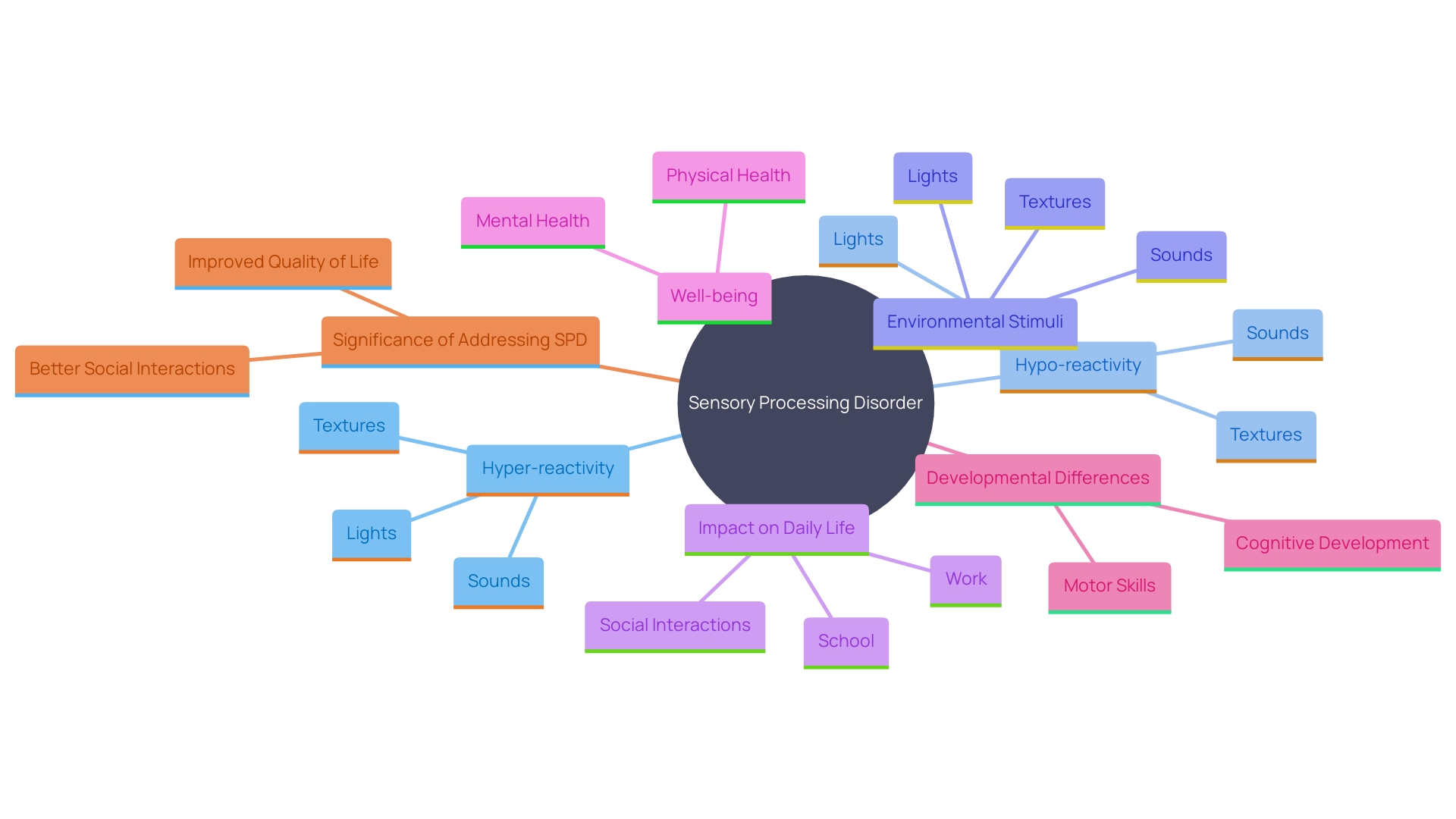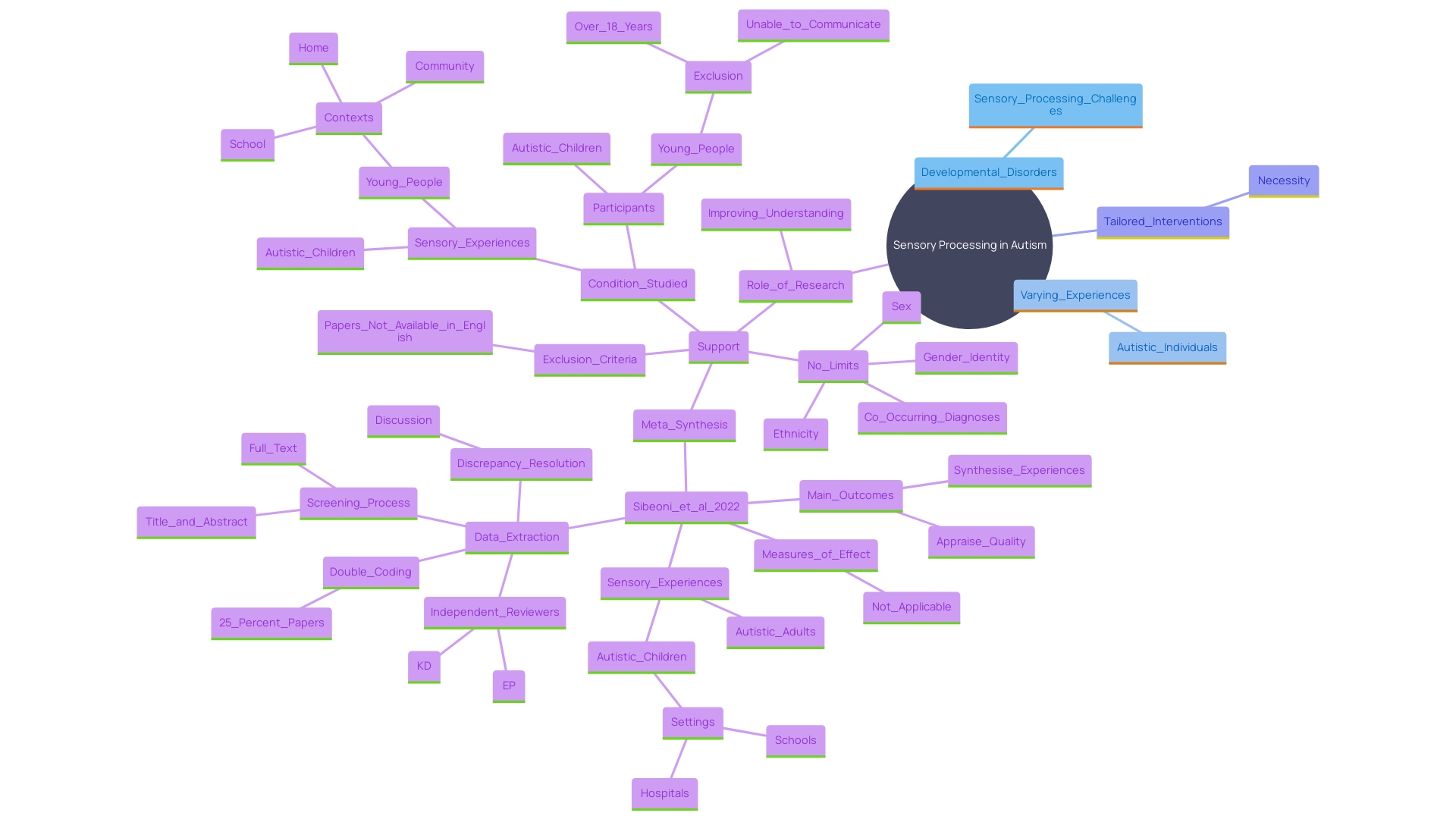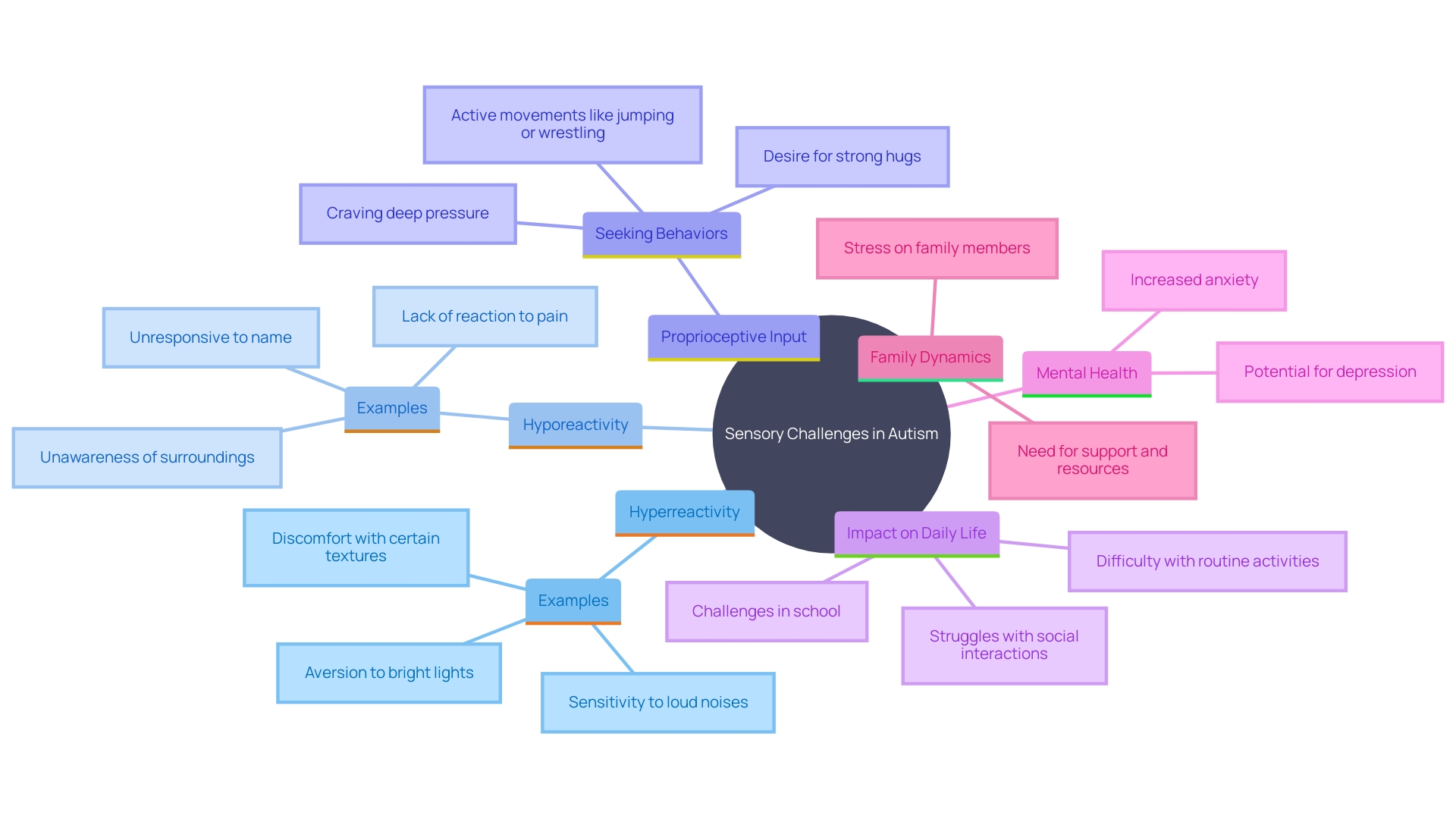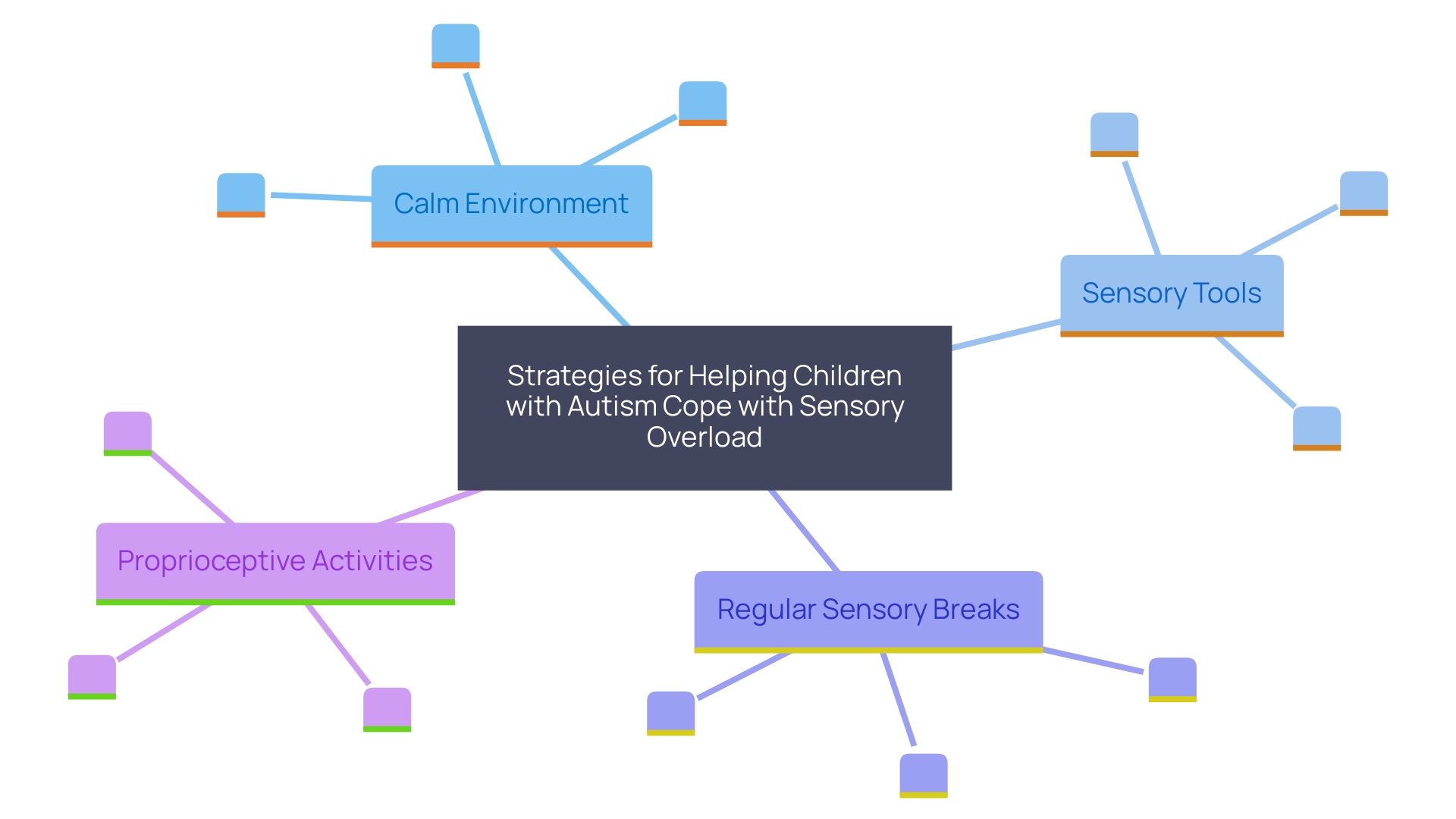Introduction
Navigating the world with Sensory Processing Disorder (SPD) can be a transformative challenge for children and young people with autism. SPD affects how the brain interprets and responds to sensory stimuli, which can significantly impact daily life and well-being. From hyperreactivity to hypo-reactivity, these sensory experiences can be overwhelming, making it essential to understand and address their unique needs.
This article delves into the profound connection between autism and SPD, explores sensory challenges such as hyperreactivity and hyporeactivity, and offers practical strategies to manage sensory overload. By creating supportive environments, particularly in schools, we can empower individuals with autism to thrive and enhance their quality of life.
Understanding Sensory Processing Disorder (SPD)
Sensory Processing Disorder (SPD) explains how the brain perceives and reacts to stimuli, greatly affecting how individuals with developmental disorders experience their surroundings. SPD can lead to hyper- or hypo-reactivity to environmental inputs, such as bright lights, loud sounds, or certain textures, profoundly affecting daily life and overall well-being. For kids and adolescents with developmental differences, these experiences can be overwhelming, making it essential to comprehend their distinct challenges. By acknowledging and tackling SPD, we can more effectively assist individuals on the spectrum in maneuvering through their perceptual environment and enhancing their quality of life.

The Connection Between Autism and Sensory Processing Disorder
Studies consistently show a substantial connection between developmental disorders and processing challenges. Numerous people on the spectrum encounter processing challenges (SPD), resulting in either increased sensitivity or reduced reactions to stimuli. This connection emphasizes the importance of tackling sensory-related challenges as an essential component of a comprehensive strategy to assist individuals with autism. Making sure that their perceptual needs are met can profoundly impact their overall well-being.
A comprehensive review of perception experiences among autistic children and young people highlights diverse responses within this population. Participants in different settings, including schools and homes, showcase a broad spectrum of experiences, further highlighting the significance of customized interventions. As mentioned by specialists such as Alison Neal, an advanced practitioner in integration therapy, practical solutions that can be applied in daily environments are crucial for effectively managing these perceptual differences.
Moreover, research initiatives, like those supported by the Interagency Autism Coordinating Committee (IACC), seek to improve our comprehension of developmental disorders and sensory processing challenges. These efforts involve monitoring language development patterns and the capability to react to sounds among children with developmental disorders, providing valuable insights for early intervention strategies.
Grasping the complex relationships within the brain, as investigated by experts such as Professors Kenkichi Takase and Eiichi Nojiri, is essential for creating a cohesive model to clarify behavioral irregularities linked to this condition. 'Their work, grounded in the groundbreaking concepts of psychologist Donald Olding Hebb, provides a thorough account of how processing challenges can affect learning, memory, and focus in those with developmental disorders.'.
Integrating these insights and real-world applications into support systems for individuals on the spectrum ensures that their perceptual needs are addressed, promoting a better quality of life and more effective management of processing issues.

Sensory Challenges in Autism: Hyperreactivity and Hyporeactivity
Individuals with autism often encounter challenges related to perception that appear as either hyperreactivity or hyporeactivity. Hyperreactivity involves heightened responses to stimuli, such as becoming overwhelmed by loud noises or bright lights. For instance, a child might cover their ears or become visibly distressed in noisy environments. On the other hand, hyporeactivity appears as a diminished response to stimuli, where individuals may not respond to pain or temperature changes, potentially resulting in unnoticed injuries. Identifying these patterns is essential for creating strategies to assist with regulation of the senses.
Recognizing that autism often accompanies ADHD because of genetic influences, it's important to note that seeking behaviors are common. A proprioceptive seeker, for example, craves physical input through activities like deep pressure, strong hugs, or active movements such as jumping or wrestling. These behaviors assist them in managing input, providing a calming effect and helping them feel more organized and in control of their environment.
Research indicates that sensory-related sensitivities can significantly impact daily life, mental health, and family dynamics. For example, individuals might be especially sensitive to bright lights, loud sounds, or strong smells, which can lead to overwhelming experiences and intense distress. This emphasizes the significance of establishing nurturing settings that meet these perceptual needs, enabling each family member to flourish.

Strategies for Managing Sensory Overload in Autistic Individuals
Handling overwhelming stimuli is essential for children with autism to engage safely and comfortably in their daily activities. Creating a calm environment can significantly reduce overstimulation, while tools like noise-canceling headphones can help manage auditory sensitivities. Creating regular breaks for the senses enables children to refresh and handle their input effectively. Based on research, between 69% and 95% of individuals on the autism spectrum encounter perceptual symptoms, emphasizing the significance of recognizing and responding to these requirements. Collaborating with professionals to identify specific triggers and develop personalized coping mechanisms empowers children to navigate overwhelming situations. For example, proprioceptive activities, such as deep pressure or active movements like jumping, can help regulate input and provide a calming effect. Dr. Nicole Sharp, an occupational therapist, stresses the importance of increasing community awareness that this condition is not something to be corrected but rather supported through understanding and suitable environmental changes.

Creating a Supportive Environment: Reducing Sensory Overload in Schools
Schools are crucial in assisting students with autism and processing challenges by creating environments that cater to their needs. Creating environments that accommodate the senses, such as dedicated rooms for this purpose, can provide a refuge for students facing sensory overload. Flexible seating setups and offering tools for stimulation, such as noise-cancelling headphones or fidget toys, can further assist students in managing their challenges related to sensory experiences.
Cooperation among teachers, occupational therapists, and families is crucial for creating tailored approaches that address each student's distinct needs related to perception. For example, developing a stimulation plan—a structured collection of activities—can assist students in maintaining balance throughout the day. Open communication with parents ensures consistency between home and school, making it easier to understand and manage specific stimuli.
The incorporation of perceptual areas within mainstream education reflects a broader shift towards inclusive and supportive learning environments. By focusing on social-emotional learning and addressing the sensory needs of students, schools can create a more holistic approach to education, allowing all students to thrive.
Conclusion
Navigating the complexities of Sensory Processing Disorder (SPD) is essential for supporting children and young people with autism. Understanding how SPD interacts with autism provides crucial insights into the unique sensory challenges faced by these individuals. The distinction between hyperreactivity and hyporeactivity highlights the varied sensory responses that can significantly impact daily life.
Recognizing these patterns is a vital step toward developing effective strategies for support and intervention.
Creating supportive environments, particularly in educational settings, plays a pivotal role in enhancing the quality of life for individuals with autism. Implementing sensory-friendly spaces, flexible seating arrangements, and personalized sensory diets can empower students to manage their sensory experiences more effectively. Collaboration among educators, therapists, and families fosters an inclusive atmosphere that addresses sensory needs, ensuring that every student can thrive.
Ultimately, understanding and addressing the sensory challenges linked to autism is not just about managing difficulties; it is about empowering individuals to navigate their worlds with confidence. By prioritizing sensory needs and fostering supportive environments, it is possible to enhance the well-being and overall development of children and young people on the autism spectrum. This commitment to understanding and support can make a profound difference in their lives, enabling them to flourish in both academic and social settings.




